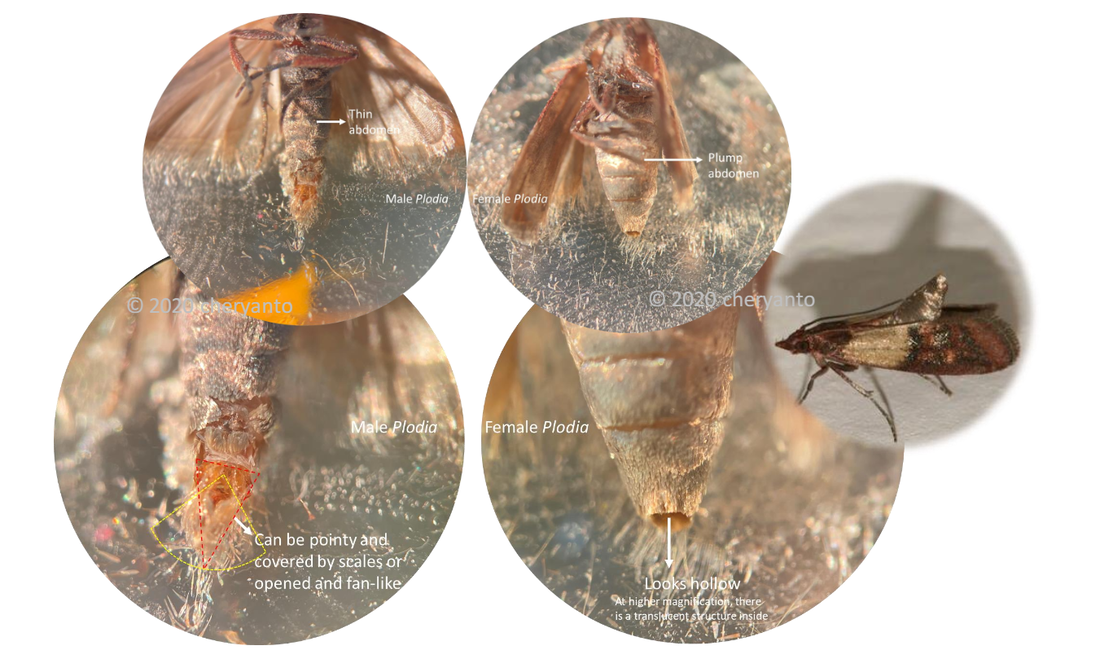Plodia have a generation of 28 days (including 2-3 days for sexual maturation of adults), when reared in an incubator with the following conditions
- Temperature: 28°C
- Humidity: 60-80% (we leave pans filled with deionized water at the bottom of our incubator)
- Light/dark cycle: 14L:10D
|
Egg to L1 larvae ~ the mean emergence time of the Pi_wFog strain is 83 h after egg laying (AEL) at 28°C for uninjected eggs, and is delayed by injection stress to 100–115 h AEL.
L1 to pupa ~ 14 days Male Plodia larvae can be distinguished from its female counterpart by the presence of two dorsal red dots indicating their testicular mass (Fig. 5). Keep handling of early larvae to a minimum and try not to open the container. When the larvae are bigger (L3-L5) then it is safe to open and isolate, when necessary. Pupal stage lasts for about 8 days at 28°C. At the end of wandering larval stage, larvae will spin silk around themselves. Once their pupal case is hardened enough, it is safe to open the cocoon and take out the pupa inside. They can then be lined up on a double-sided tape that has been dabbed with a kimwipe to reduce stickiness. Pupal staging is based on their body, eye, tarsal claw, and wing color progression from cream, tan, to dark brown. Zimowska et al (1991) described in detail how to stage the pupae through observable outer structure and how those stages relate to the ovary maturity.
|
Left: Differences between male and female Plodia larvae. Arrowhead: larval testicular mass used for sexing in WT moth larvae. Right: Dissected testicular mass.
|
|
Sexing Plodia pupae is performed under dissection microscope. In females, the abdominal segments on the ventral side near their genitalia are shaped distinctively (dotted lines) from males. Males also have a pair of rounded sex marker near their genitalia. In addition, the distance between anus and genitalia in male is generally shorter than in female pupae. |
It's also easy to determine the sex at the adult stage:
Apart from the morphological differences illustrated above, adult male and female Plodia also show difference in pre-mating behaviors. Females will bend their abdomen upwards to call males for mating using their pheromones. As a response, males will flap their wings to court the nearby female.
Isolating unmated individuals for crossing
The easiest and cleanest way to isolate unmated Plodia for crossing is by using cardboard (hotels) to separate pupae. These hotels will provide safe shelter and attract wandering larvae to start pupation. Conveniently, the indentation size is also small enough to only contain one larva each.
It is important to choose clean cardboard as to not infect the entire stock container and take them out as soon as the hotels are filled. Prolonged storage in the container might introduce mold and web overgrowth around the hotels, making them harder to take out.
It is important to choose clean cardboard as to not infect the entire stock container and take them out as soon as the hotels are filled. Prolonged storage in the container might introduce mold and web overgrowth around the hotels, making them harder to take out.

- Cut cardboard strips of about 2 cm in width. Drop these "hotels" in a Plodia container with wandering larvae. These larvae stopped feeding and show an exploratory behavior in the box, looking for a pupation site. Leave for 2-3 days to obtain a mix of pupae and pre-pupae.
- Peel out the cardboard and to isolate pupae. Pre-pupae (larvae encircled by their thin silk cocoon) can be left alone for 1-2 extra days until they pupate. Pupae can be sorted by sex easily using examination under a standard binocular microscope. Alternatively, you can let the moths emerge and determine their sex later as adults.
- Place an individual cocoon together with a small piece or ball of paper towel inside a 1.25 oz cup. The paper towel helps the moth to emerge, and will help absorbing the meconium (waste fluid excreted shortly after adult emergence.
- Cross by mixing male and female together in a cup. Mixing 1 male : 2 females, or 1 female : 2 males, can increase chances of successful mating, and is standard procedure when outcrossing G0 injectees to propagate a transgene or CRISPR allele to an F1 generation. Females are often seen bending their abdomen up, a position in which they are exposing their pheromone gland to call males. When you add a male to a calling female, you will tend to see the male immediately performing its courtship behavior. Mating is often immediate in this case. If moths are not mating, leave in the dark for a few days..
- To grow the progenies from these crossings, simply place the cup open in a food container.







